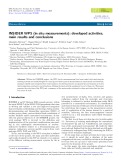
REGULAR ARTICLE
INSIDER WP5 (in situ measurements): developed activities,
main results and conclusions
Margarita Herranz
1,*
, Raquel Idoeta
1
, Khalil Amgarou
2
, Frédéric Aspe
3
, Csilla Csöme
4
,
Sven Boden
5
, and Marielle Crozet
6
1
Nuclear Engineering and Fluid Mechanics dpt., University of the Basque Country (UPV/EHU), Pza. Ingeniero Torres
Quevedo 1, 48013 Bilbao, Spain
2
Commissariat à l’énergie atomique et aux énergies alternatives CEA, Direction de l’énergie nucléaire DEN, DDCC/CCMA/
GA2P, Marcoule, BP 17171, 30207 Bagnols sur Cèze Cedex, France
3
Mesures Nucléaires, ONET Technologies, 970 chemin des agriculteurs, 26701 Pierrelatte, France
4
Nuclear Security Department, Centre for Energy Research (EK), Konkoly-Thege M. 29-33,1021 Budapest, Hungary
5
Dismantling, Decontamination and Waste Expert Group, Belgian Nuclear Research Centre (SCK•CEN), Boeretang 200,
2400 Mol, Belgium
6
Commissariat à l’énergie atomique et aux énergies alternatives CEA, Direction de l’énergie nucléaire DEN, DMRC, Univ.
Montpellier, Marcoule, BP 17171, 30207 Bagnols sur Cèze Cedex, France
Received: 14 September 2019 / Received in final form: 19 November 2019 / Accepted: 10 December 2019
Abstract. Within the INSIDER project, the WP5 (in situ measurements) has been tasked with analysing the
existing systems and methodologies for carrying out these types of measurements in constrained environments,
aiming to classify and categorise these environments. An additional task is to organise the participation in in situ
intercomparison exercises in real situations, defining the most suitable equipment to carry these out. This paper
presents the activities of the WP5 and a summary of the main results obtained in these activities after the first
two years of work.
1 Introduction
INSIDER is an EU Horizon 2020 research project, within
the topic NFRP-7 of the EURATOM programme that aims
to develop and validate a new and improved integrated
characterisation methodology and strategy during nuclear
decommissioning and dismantling operations (D&D) of
nuclear power plants, post-accidental land remediation of
nuclear facilities under constrained environments. In line
with the general objectives of the INSIDER project, the
work package WP5 is devoted to the definition and
implementation of the practical considerations surround-
ing in situ radiological characterization of nuclear/
radioactive facilities subject to a decommissioning pro-
gramme, taking into account specific outputs from work
packages WP2, WP3 and WP4.
So far, and according to the WP5 work plan as defined
at the start of the project, the main activities undertaken
and results obtained by this WP are related to: (a) analysis
of the different existing measurement systems for the in
situ measurement of alpha, beta, neutron and gamma
radiations emitted from the materials and structures
belonging to radioactive/nuclear installations under D&D
processes in a constrained environment, (b) classification
and characterization of this type of environments, based on
the restrictions they impose on the measurement system
and (c) application of the lessons learned to a practical
situation, achieving the first intercomparison exercise
carried out in a real installation under D&D decommis-
sioning process.
The first two of these activities have led to deliverables
5.1: “Inventory of existing methodologies for constrained
environments”[1] and 5.2: “Classification and categoriza-
tion of the constrained environments”[2], while the third
one is already finished but the data obtained are still under
evaluation by colleagues from WP6, remaining the WP5 in
charge of the technical challenges.
At the same time, as these activities have been carried
out, it should be noted that a database of the main
companies which carry out D&D activities at the European
level has been set up and it will remain operational and
open for the duration of the project.
In this paper, the main conclusions obtained during
these tasks are briefly presented and analysed.
*e-mail: m.herranz@ehu.eus
EPJ Nuclear Sci. Technol. 6, 12 (2020)
©M. Herranz et al., published by EDP Sciences, 2020
https://doi.org/10.1051/epjn/2019061
Nuclear
Sciences
& Technologies
Available online at:
https://www.epj-n.org
This is an Open Access article distributed under the terms of the Creative Commons Attribution License (https://creativecommons.org/licenses/by/4.0),
which permits unrestricted use, distribution, and reproduction in any medium, provided the original work is properly cited.





















